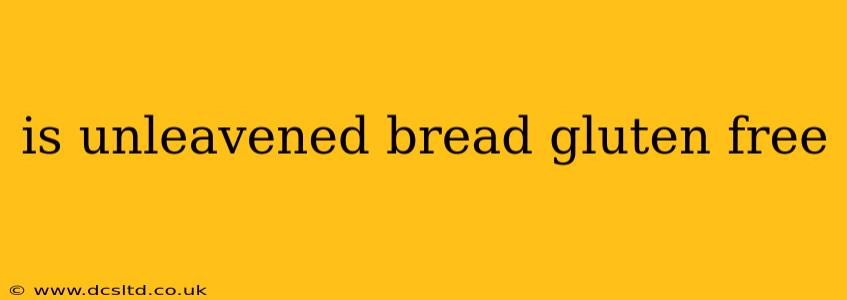The question of whether unleavened bread is gluten-free is more nuanced than a simple yes or no. While the process of making unleavened bread—which involves omitting leavening agents like yeast—doesn't inherently remove gluten, the ingredients used determine its gluten-free status. Let's delve deeper.
What is Unleavened Bread?
Unleavened bread, also known as flatbread, is bread made without any leavening agents. This means no yeast, baking powder, or baking soda is added to make the dough rise. Instead, it relies solely on the water and flour to create its structure. Historically, unleavened bread holds significant religious and cultural importance, particularly in Jewish traditions (matzah) and some other cultures.
The Gluten Factor: It's All About the Flour
The key to understanding whether a specific unleavened bread is gluten-free lies in its flour content. Gluten is a protein found in wheat, barley, and rye. Therefore:
-
Unleavened bread made with wheat flour is NOT gluten-free. This includes common varieties like many types of pita bread, tortillas (depending on the recipe), and some flatbreads from around the world. Even without yeast, the gluten proteins in wheat flour are present and will cause a reaction in individuals with celiac disease or gluten sensitivity.
-
Unleavened bread made with gluten-free flours IS gluten-free. Many gluten-free flours exist, including rice flour, almond flour, corn flour, coconut flour, and various blends. If the recipe utilizes any of these, the resulting unleavened bread will be safe for those following a gluten-free diet. Always check the ingredients list carefully!
What About Matzah? Is Matzah Gluten-Free?
Matzah, the unleavened bread eaten during Passover, is traditionally made from wheat flour. Therefore, matzah is NOT gluten-free. However, there are now commercially available gluten-free matzah options made with gluten-free flours. Again, always check the packaging to ensure it's specifically labeled gluten-free.
How is Gluten-Free Matzah Made?
Gluten-free matzah utilizes alternative flours like potato starch, tapioca starch, or rice flour to create a similar texture to traditional matzah, while remaining free of wheat proteins.
Frequently Asked Questions (FAQ)
Here are some common questions people ask about unleavened bread and gluten:
Is all flatbread gluten-free?
No. Flatbread is a broad category encompassing many types of bread, including those made with wheat flour (and therefore containing gluten). Whether or not a particular flatbread is gluten-free depends entirely on its ingredients.
Are tortillas unleavened bread?
Some tortillas are unleavened, while others are leavened. Many corn tortillas are unleavened, but wheat tortillas generally contain gluten. Always check the ingredient list.
Can I make unleavened bread at home that is gluten-free?
Yes! You can easily make gluten-free unleavened bread at home using gluten-free flour blends. Many recipes are readily available online. Remember to use a dedicated gluten-free work surface and utensils to avoid cross-contamination.
What are the best gluten-free flours for making unleavened bread?
Rice flour, tapioca starch, and almond flour are popular choices for making gluten-free unleavened bread, although many blends offer a good balance of texture and flavor.
In conclusion, the gluten-free status of unleavened bread hinges entirely on the type of flour used. Always carefully read the ingredients list before consuming any unleavened bread, especially if you have celiac disease or a gluten sensitivity.
